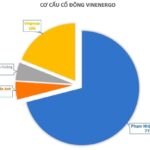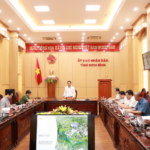“Drone Technology: Revolutionizing Industries and Reducing Carbon Emissions”
As shared by Mr. Vo Duy Qui, drones, or unmanned aerial vehicles (UAVs), belong to a young industry that has evolved over the last decade. Globally, as of January 2025, over 1 million drones have been registered, with approximately 420,000 drones serving commercial purposes, and the numbers continue to grow daily. In Vietnam alone, the agricultural sector has imported over 10,000 drones, excluding domestically produced ones.
Interestingly, while drones may contribute to a certain level of emissions, their significance lies in significantly reducing carbon emissions in multiple sectors. Currently, drones are being utilized in agriculture, industry, infrastructure, surveying, and logistics. This is primarily because drones are powered by batteries, and although the discussion of clean energy sources for these batteries is ongoing (with hydrogen being limited and lithium-ion batteries being prevalent), they still reduce carbon emissions compared to fossil fuels and undoubtedly lower CO2 emissions.

Mr. Vu Duy Qui (left) and fellow speakers at the event
|
Speaking of numbers
According to Mr. Qui, when calculating emission reductions, a single hectare of agricultural land using drones compared to other methods that rely on diesel or fossil fuels can reduce over 51 kg of CO2. Extrapolating this, 500 million hectares of agricultural land utilizing drones could result in a reduction of 25.7 million tons of CO2.
Additionally, employing drones for pesticide spraying and fertilizer distribution over equivalent areas also leads to substantial water and chemical savings, estimated at 210 million cubic meters in agriculture. There are further benefits, such as soil regeneration, that have not been precisely quantified in studies yet.
In the industrial sector, drones are commonly used for inspecting power lines, wind turbine towers, and solar panels. This practice significantly reduces CO2 emissions compared to using helicopters. For instance, patrolling 22,000 km of power lines with drones can save 258 tons of CO2 compared to using helicopters. Each hour of drone flight emits less than 5 kg of CO2, while a helicopter emits 235 kg. Drones also contribute to reduced noise pollution due to their quieter operation compared to conventional aircraft.
The use of drones also enhances safety by eliminating the need for direct human involvement in accessing hazardous and challenging areas, such as coal mines, cement plants, and mountainous regions.
Another application mentioned by Mr. Qui is their use in digital twinning and 3D mapping. Drones facilitate the creation of online 3D maps, which are then used for simulations and predictions of various infrastructure-related scenarios across industries like construction, architecture, energy, and transportation.
In the realm of logistics, Mr. Qui highlighted the emerging trend of drone usage. For instance, in Shenzhen, China, cargo stations have been established, enabling drones to transport payloads of up to 40 kg within a range of 10-20 km. Similarly, in Vietnam, a company in the oil and gas sector has adopted four drones for cargo delivery (including meals for engineers and supplies) to offshore drilling rigs, reducing carbon emissions and operational costs.
Remarkably, a delivery drone can reduce carbon emissions by almost 30 times compared to an individual driving a car to the supermarket. According to the director of Aonic, drones also boost efficiency by up to 94% compared to fossil fuel-powered cars and reduce 2-3 tons of carbon annually.
Persisting challenges
Despite the numerous benefits, Mr. Qui acknowledged that drone applications face several obstacles. Firstly, strict legal regulations, including licensing requirements and flight restrictions related to security and defense, pose significant challenges.
Secondly, the infrastructure for charging drone batteries is currently limited. Similar to electric vehicles, the lack of charging stations hinders the continuous and large-scale operation of drones.
Additionally, there are data integration complexities and the need for accurate methods to measure and improve carbon emissions associated with drone usage.
Lastly, there is a barrier of perception, as business leaders may be hesitant to embrace and experiment with new technologies. This reluctance is identified as a significant impediment to the development of drones in Vietnam.
Hence, Mr. Qui emphasized the necessity of fostering a fresh mindset to overcome technological biases and encourage the integration of drones in various sectors, including agriculture, industry, rescue operations, and transportation. Furthermore, he advocated for seamless collaboration between leaders, employees, and partners to collectively reduce carbon emissions.
“Emission reduction is not just an investment; it is a necessity for the sustainability of our environment and planet,” quoted Mr. Qui.
|
The event, “Celebrating World Environment Day 2025 – Leading Sustainable Development: Understanding Carbon and Ecological Footprints,” organized by the Green Leadership Community (GLC) on June 14th, was part of the Sustainable Future series. The seminar offered diverse professional perspectives on the sustainable and unsustainable development of various industries based on multiple measurement indices, including carbon footprint and ecological footprint. |
Unlocking Vietnam’s Railway Renaissance: A Visionary Proposal from the Prime Minister to Transform the Industry with a $24.5 Billion Revenue Giant.
The company’s forte lies in transportation and logistics. With a fleet of cutting-edge vehicles and a team of industry veterans, they navigate the complexities of modern transportation with ease. Their expertise spans across land, sea, and air, ensuring seamless delivery every time. This group is the linchpin that keeps the world’s supply chains turning.
The Great Wall of China: An Engineering Marvel and a Boon for the Nation’s Seafood Industry
The “wonder” is envisioned to be up and running by 2026. A marvel to behold, this project is set to revolutionize the industry and captivate audiences far and wide. With its cutting-edge design and innovative features, it promises an experience unlike any other. Mark your calendars and get ready to witness the future unfold!
“Unleashing the Power of Insurance: Empowering Banks to Take the Leap.”
The insurance market can only truly thrive and develop sustainably when there is a proactive approach to engaging with the underserved, reaching out to new customer segments, and addressing unmet needs.














































